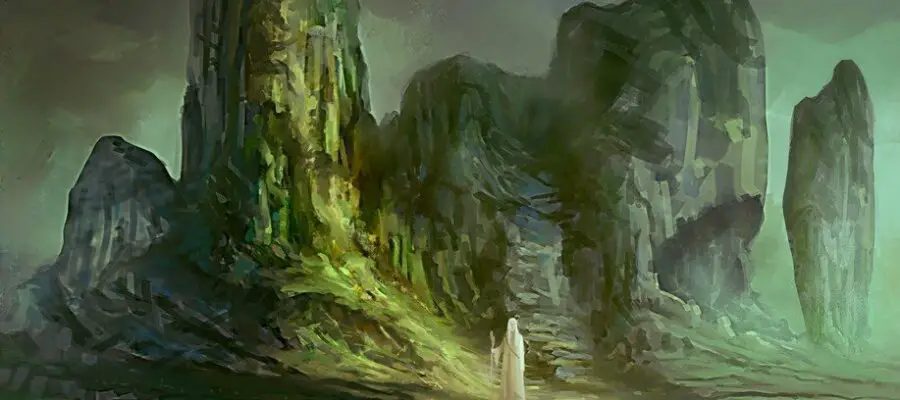“The Druid” by elbardo, CC Attribution-Noncommercial-No Derivative Works 3.0 License
In the previous two parts, we’ve looked at Druid spells that give advantage to your team’s attack, protect your team from assailants, and even a spell that brings a character back from the dead. In this final section, we’ll look at spell levels 7-9 that really bring the heroic utility every Druid should possess.
Fire Storm (Level 7)
On the high seas, a pirate ship on your tail gains quickly. You fear you will soon be overrun. In a fiery storm of chaos, you conjure ten cubes of fire and shoot them at the sails, the deck, and most importantly, the barrels of gunpowder. The ship explodes in a hot inferno as you speed away.
Pros: As a colossal act of power, the Fire Storm spell sends a curtain of ten fire cubes, arranged how the player chooses, up to 150 feet away. Upon a failed dex save, creatures take 7d10 fire damage, and anything flammable catches on fire. With this awesome spell, you can shape your fire cubes however you want, consuming your targets in a tetris-style wall of wrath.
Cons: I can’t really see a con to this spell. It all depends on how you use it.
Reverse Gravity (Level 7)
Your party is trapped in a cult’s cathedral. The cultists corner you, ready to attack. There are too many of them to fight, and you don’t see a way out. You focus your mind and cast Reverse Gravity. All of the cult members fly to the ceiling. Your party escapes, and upon leaving, you release your spell, hurtling the cultists toward the stony ground.
Pros: With a casting range of 100 feet, you can safely cast this spell away from your location. With a cylinder of 50 feet by 100 feet, you can capture dozens of medium-sized creatures, lifting (or dropping, more accurately) to the top of the cylinder. This effect lasts for one minute (ten rounds), providing time to accomplish your goals. The most fun part is dropping enemies to the ground. Falling damage is calculated as 1d6 for every ten feet of fall (caps at 20d6). So if your targets take the full 100 foot fall, that’s 10d6 damage, and you could be long gone by then.
Cons: This spell does require concentration and a dexterity saving throw. If a character is anchored to the floor already, they will not fall to the sky, and your team members could get caught in the cylinder.
Regenerate (Level 7)
Your barbarian has taken a beating. The battle is over, but you must venture on through the labyrinth. His sword-holding severed hand writhes on the grassy ground. You wrap it in some cloth and cast Regenerate. The barbarian looks instantly rejuvenated. You hold the hand to his bloody stump, and it magically reattaches as your party continues toward the epic campaign end.
Pros: Regenerate is one of the most powerful healing spells a Druid can get. Not only does it not require concentration, but your target gets 4d8+15 hit points immediately, and severed limbs reattach after two minutes if you have them. But here’s the coolest part: each round for an hour, your target regains 1 hit point at the start of its turn. This means that if the character gets knocked out before its turn, she regains one hit point and thus consciousness for AN ENTIRE HOUR. Unless she somehow gets killed during that time, she basically can’t die.
Cons: Competition with other level-7 spells to choose from, this being one of them. That’s really the only con I can picture.
Tsunami (Level 8)
A horde of undead soldiers run toward your party from a mile away. Before anyone else in your party can do anything, you maniacally laugh as you conjure a 300×300-foot raging wave of water that sweeps over the entire horde. The wall of water crashes them 300 feet back, most of them in pieces now. Your party applauds your work. There is much rejoicing.
Pros: This is one of the coolest utility and damage-dealing spells a Druid has in his arsenal. A huge wave pushes creatures back each round, dealing a good amount of 6d10 damage decreasing each round. Best of all, this spell’s range is only limited to sight. The average 6-foot tall human can see up to three miles. Imagine the havoc you can wreak. This range is insanely powerful! Not many spells are given a figurative blank check on their range.
Cons: This spell requires concentration, and targets can make strength saving throws to try to swim out of the wave. If your visibility is limited, this could backfire as it’s too close to your team.
Storm of Vengeance (Level 9)
An enemy army camps a mile away. You can see them preparing for war against an allied city. Keeping yourself hidden, you invoke a storm over the enemies. With a deafening boom, acid rains upon them, then lightning strikes the leaders and weaponry arsenal. Hail strikes down the men, now running for their lives. But a cold cloud descends, obscuring their views. Now is your team’s chance to strike!
Pros: With a range of “sight,” this spell deafens and deals a lot of damage in ten rounds and produces new effects each round you maintain your concentration, which every creature in the 360 feet radius of the storm takes. That means you can effect hundreds of creatures and several structures. In round 2, you can choose 10 creatures OR OBJECTS to strike with powerful lightning, effectively destroying gear, weapons, gunpowder, food supplies—whatever your heart desires. In the last 6 rounds, ranged weapon attacks and spell concentrations become nearly impossible.
Cons: Concentration. The first five rounds give new effects, but you have to stay concentrating through those rounds to get the cool effects. Also, the targets can make a constitution saving throw to avoid being deafened, a dexterity saving throw to avoid lightning, and can run out of the radius if they’re close enough to the edge of the storm.
Conclusion
One of the greatest challenges players face is choosing to expend those few precious high-level spell slots. With this post, our hope is to encourage players to get the most out of their level 7-9 spells. Can you think of other uses for these spells or other Druid spells we didn’t cover? Let us know in the comments!
Part 1 | Part 2




